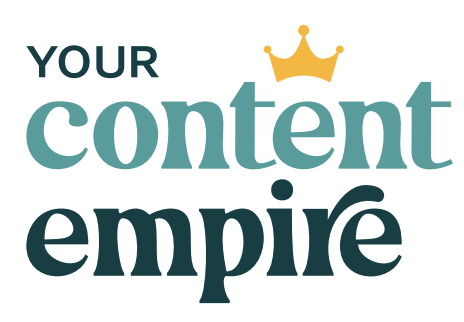Ever catch yourself thinking “marketing used to be so much easier” or “my marketing stopped working!”
You're not imagining it. Between plummeting social media reach, AI-generated content flooding your feed, and a world that seems to serve up a new crisis every morning, marketing feels a bit like navigating an obstacle course – blindfolded
But here's the thing: while the landscape has undeniably changed, that doesn't mean effective marketing is out of reach. It just means we need to shift our approach.
Prefer to watch this video?
Want to listen to this on the go?
Recently, I've been having the same conversation over and over with business owners. Whether they're just starting out or have been in the game for years, they all share a common frustration: marketing just feels harder than it used to. And they're right—but not for the reasons you might think.
After diving deep into the data, speaking with hundreds of entrepreneurs, and testing what's working (and what's not) in my own business, I've identified four key factors that are making marketing feel like pushing a boulder uphill. But more importantly, I've uncovered specific shifts you can make to adapt to this new reality. Let's break it down.
Reason #1: Diminishing Returns
Remember when posting on social media felt like shouting from a rooftop, and everyone in the neighbourhood could hear you?
Those days are becoming a distant memory. If you're feeling like your marketing efforts aren't hitting quite as hard as they used to, you're not alone—and more importantly, you're not imagining it.
The truth is, we're experiencing a significant shift in marketing effectiveness across the board. Think about it: you're putting in the same amount of work (if not more) to create and distribute your content, but the return on that investment keeps shrinking and shrinking.
Recent data from Social Insider shows that Instagram posts now reach only about 4% of your followers on average—an 18% drop from last year. That means for every 1,000 followers you have, only 40 people are likely seeing your post.
So what do you do about it?
The good news: this isn't a sign to throw in the towel. Instead, it's an opportunity to make strategic shifts in how you approach your marketing.
First, it's time to double down on channels you actually own, like your email list, where you're not at the mercy of algorithmic changes. So make growing your list and send regular emails a priority.
Second, focus on deepening relationships with your existing community—those already engaging with your content and buying offers are your main focus. If you're on Instagram, you can add these people to your “favourites” feed so you see their content and can engage with them there. The people who already know you are most likely to engage back which creates a positive feedback loop with the algorithm and helps your overall visibility.
Finally, implement systems that streamline your content creation and distribution process, so you can maintain consistency without burning out. For example: where can you create templates? Where can you set up automations? Where can you outsource effectively?
Reason #2: Increasingly Saturated Markets
With more people selling online than ever (the global digital products market is on track to hit $331 billion by 2025 according to Sellfy), the market has become very noisy and very saturated. Everyone and their mother wants a piece of that pie.
And that's only been compounded by the tech disruption of AI making it easier and easier for people to generate content. The rise of AI-generated content has led to a paradox—more content doesn't mean better content.
The thing to remember about AI is it's a language predication model. So it's going give you the same spiel that everyone is getting (unless you know how to prompt it and feed it great source material, but that's a convo for another day) but if everyone is using the same AI generated content, it's all going to start sounding the same.
So how do you stand out?
First and foremost, focus on originality over volume. I've heard a lot of people claim that, in the age of AI, education content is dead. I don't think that's 100% true—but I do think your content and ideas must be based on your lived experiences and original ideas. Even better if you can jump on video and let your personality give your content even more of a unique edge.
Next, prioritize community. We've already touched on engagement in reason #1, but it's a twofer and can help you build the community you need to help people start seeking out your content even if it's not being served on a silver platter by the algorithm. You can give your community building an assist by adding in opportunities for real-time engagement like live video, virtual coffee chats, can't-miss online events. These real-time interactions can't be replicated by AI.
Reason #3: Consumer Expectations
Gone are the days when a catchy headline and a few testimonials were enough to win over your audience. Today's consumers aren't just savvy—they're practically professional investigators when it comes to where they spend their dollars. With economic pressures mounting and higher interest rates squeezing budgets, every purchase decision is under the microscope.
But while conventional wisdom might suggest that economic uncertainty leads to decreased spending, what we're actually seeing is a shift in how people invest, especially in the B2B space. Rising interest rates and inflation have pushed borrowing costs higher for businesses, creating a more competitive landscape where only the most convincing value propositions win. But instead of not spending at all, people are simply becoming more thorough in their evaluation process.
So how can you make your offer as valuable as it seems:
Don't take shortcuts on your offer messaging: Test multiple angles and promises for your offers, and more importantly, ensure your delivery matches or exceeds every claim. Your reputation depends on it. And any short-term gains from overpromising and underdelivering will disappear in the long-term.
Invest in the long-term relationship over the short-term conversion: Especially if you're spending money on ads to attract leads, remember that your job isn't done when they join your list—it's just the beginning. I've seen people waste a lot of money bringing in new leads and then when they don't immediately turn into customers, write them off. Keep showing up in their inbox with valuable content, community-building invitations and, once in a while, paid opportunities.
Another option is to diversify your pricing tiers – if you have only small priced products you're going to need a lot of sales to hit your revenue goals, if you only have high ticket, you might struggle to build the track record you need to convince an audience who's becoming more and more discerning with smaller priced taste testers.
Reason #4: Divisive World Events
Let's talk about the elephant in the room and what I see as the final big factor in why marketing feels harder now than ever is the constant stream of global events that keeps us all walking on marketing eggshells. Whether it's politics, war, natural disasters or other headlines, if you've found yourself second-guessing your content calendar or holding back on scheduling posts too far in advance, you're not alone.
We're living in an era where the next major headline could shift the entire conversation in an instant.
So how do you navigate this? Here are a few shifts:
Reframe your work: Remember that your work matters (even if it doesn't feel like you're making a massive impact all the time). And if you're having trouble tapping into that mindset, revisit your purpose—how does what you do support the greater good? Think about how you're helping people navigate their challenges, regardless of what's happening in the world. Sometimes the most valuable thing you can offer is a sense of normalcy and progress.
Stay flexible with your content and scheduling: Sometimes the right thing to do is to clear your outgoing content and that's much easier to do if you have weeks or months worth of content to unschedule. How I navigate this is that even though I batch my content a month in advance, we only schedule a week at a time (unless vacations are planned)
Draw boundaries: Decide where your personal voice ends and your business voice begins. Maybe you'll speak out about certain issues on your personal profiles while keeping your business channels focused on your expertise. Or perhaps you'll weave both together—there's no universal right answer. What matters is having clear guidelines for which conversations belong where, making those split-second decisions during major events much less stressful and more aligned with your overall brand.
So what’s next?
After outlining these four major shifts in the marketing landscape, you might be wondering how this applies specifically to your business. Where exactly should you focus your efforts first? What strategies will give you the biggest bang for your buck right now?
That's exactly why I've created the “What Got You Here Won't Get You There” Marketing Review. Get my eyes on your current marketing efforts and a personalized roadmap forward. I'll analyze what's working, what needs tweaking, and identify at least three specific opportunities you can implement right away to adapt to this new marketing landscape.
No fluff, no generic advice—just practical, actionable insights delivered within 2 business days. Because while marketing might be getting harder, having a clear path forward makes all the difference.
Ready to turn these challenges into opportunities? Grab the link here to get your marketing review and let's make sure your strategy is built for today's reality, not yesterday's playbook.












